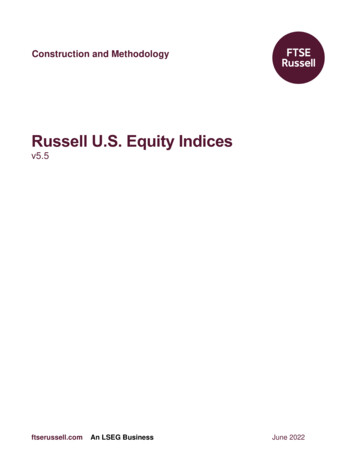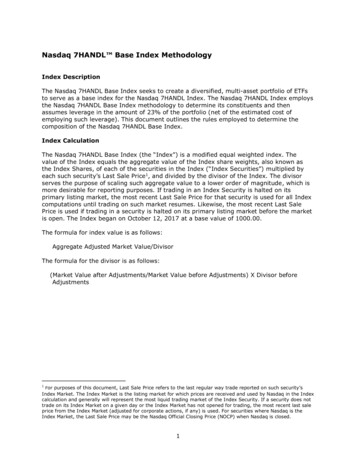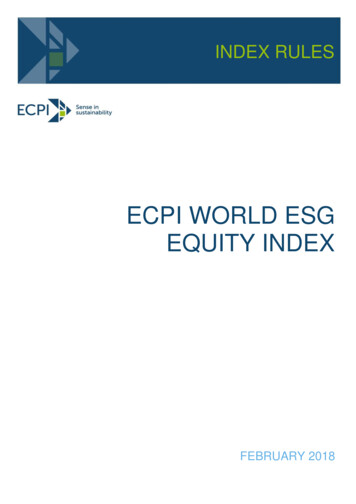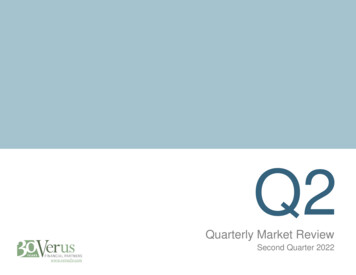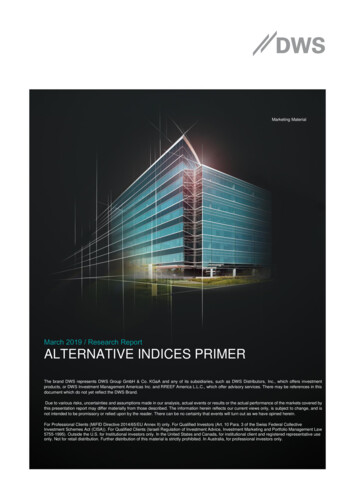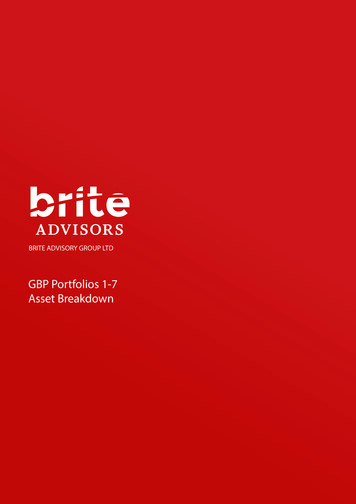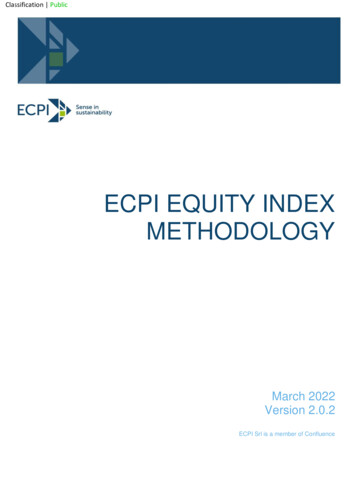
Transcription
Classification PublicECPI EQUITY INDEXMETHODOLOGYMarch 2022Version 2.0.2ECPI Srl is a member of Confluence
Classification Public2TABLE OF CONTENTINTRODUCTION . 4GUIDING PRINCIPLES . 5CAPITALIZATION WEIGHTED INDICES - SINGLE COMPANY CAPPING 4%. 6EQUAL WEIGHTED INDICES . 11CURRENCY HEDGED INDICES . 15VOLATILITY CONTROL INDICES . 16ECPI WORLD ESG INDEX . 19ECPI GLOBAL DEVELOPED ESG BEST-IN-CLASS INDEX . 21ECPI EURO ESG INDEX . 23ECPI GLOBAL ETHICAL INDEX . 26ECPI EURO ETHICAL INDEX . 28ECPI EMU ETHICAL INDEX . 31ECPI EMERGING MARKETS ESG INDEX . 34ECPI ASIAN INFRASTRUCTURE INDEX . 36ECPI CHILDREN’S RIGHTS LEADERS INDEX . 38ECPI CHINA CONSUMPTION TRADABLE INDEX . 40ECPI CIRCULAR ECONOMY LEADERS INDEX . 41ECPI CIRCULAR ECONOMY LEADERS NTR 3.5% DECREMENT INDEX . 44ECPI DIGITAL REVOLUTION INDEX . 45ECPI GLOBAL AGRICULTURE LIQUID INDEX. 47ECPI GLOBAL BLUE GOLD INDEX . 49ECPI GLOBAL CARBON LIQUID INDEX . 51ECPI GLOBAL CLEAN ENERGY INDEX . 53ECPI GLOBAL CLIMATE CHANGE INDEX . 55ECPI GLOBAL COMMODITY GD INDEX . 57ECPI GLOBAL ECO REAL ESTATE & BUILDING LIQUID INDEX . 59ECPI GLOBAL ESG BLUE ECONOMY INDEX . 61ECPI GLOBAL ESG HEALTHCARE INDEX. 64ECPI GLOBAL ESG TECHNOLOGY INDEX . 65ECPI GLOBAL ESG INFRASTRUCTURE INDEX . 67ECPI GLOBAL LIVESTOCK GD INDEX . 69ECPI GLOBAL LONGEVITY WINNERS INDEX . 70ECPI GLOBAL MEGATREND 100 INDEX . 72ECPI Srl is a member of Confluence. All rights reserved.
Classification Public3ECPI GLOBAL RENEWABLE ENERGY INDEX. 74ECPI GLOBAL SCIENCE FOR LIFE INDEX . 76ECPI ROBOTICS & ARTIFICIAL INTELLIGENCE INDEX . 78ECPI GLOBAL ESG FUTURE MOBILITY INDEX . 80ECPI GLOBAL ESG FUTURE MOBILITY NTR 3.5% DECREMENT INDEX . 82ECPI GLOBAL ESG MILLENNIAL INDEX . 83ECPI GLOBAL ESG MULTITREND INDEX . 85ECPI GLOBAL ESG RECOVERY INDEX . 87ECPI GLOBAL ESG RECOVERY 10% RISK CONTROL INDEX . 89ECPI GLOBAL ESG AGRI-BUSINESS INDEX . 91ECPI GLOBAL ESG HEALTCARE INNOVATION INDEX . 93ECPI GLOBAL ESG GENDER EQUALITY INDEX . 95ECPI GLOBAL ESG CYBERSECURITY INDEX. 97ECPI GLOBAL ESG HYDROGEN ECONOMY INDEX . 99ECPI GLOBAL ESG HYDROGEN ECONOMY ntr 3.5% DECREMENT INDEX . 102ECPI GLOBAL ESG MEDICAL TECH INDEX . 103ECPI GLOBAL ESG CYBERSECURITY & BIG DATA INDEX . 106ECPI GLOBAL ESG SMART CITIES INDEX . 108COMPLIANCE STATEMENT . 111EU BENCHMARK REGULATION DISCLOSURE . 113ECPI ESG SCREENING METHODOLOGY AND RATING . 118THE TEN PRINCIPLES OF THE UN GLOBAL COMPACT . 120APPENDIX A: DIVIDEND WITHHOLDING TAXES . 121APPENDIX B: DEFINITIONS . 122APPENDIX C – GLOBAL DEVELOPED MARKETS . 123APPENDIX D – EMERGING MARKETS . 124CONTACTS . 125ECPI Srl is a member of Confluence. All rights reserved.
Classification Public4INTRODUCTIONThe present document defines the rules for the calculation and management of the ECPI Equity Indices.The Index Rules and Index Constituents are available on ECPI’s website, www.ecpigroup.com, as well as on theConfluence website at: https://www.confluence.com/index-governance/ and/or can be requested atecpi.indices@confuence.com.ECPI SUSTAINABLE INDICESThe objective of ECPI Indices is that of providing the user with tradable indices that in their construction andmanagement consider, in addition to traditional financial criteria, also non-financial dimensions.All ECPI Indices are characterized by (i) either a rigorous exclusion of companies that operate in certain sectors incoherence with the ethical sensibility of the investor and/or by (ii) a positive selection of companies that demonstratea solid ESG profile.ECPI Indices may be used as the basis for various investment vehicles: they allow for an efficient implementation ofsocially responsible or sustainable mandates as well as index-tracking portfolios and exchange traded funds.Socially Responsible and Sustainability criteria used to select the indices’ constituents, offer a conduit for investorsto jointly express their interest in sustainability and, thus, to collectively move the relevant issues up the corporateagenda.StatPro Ltd, a Confluence Company, is the Index Administrator of the ECPI Equity Index Family.ECPI Srl is a member of Confluence. All rights reserved.
Classification Public5GUIDING PRINCIPLESThe ECPI Socially Responsible & ESG Equity Indices family is built and maintained according to the followingprinciples: Market RepresentationThe indices represent the reference markets and reflect the opportunities available to the investors. Themain criteria used to ensure market representation are market capitalization and sector composition. Investible and ReplicableThe indices should be capable of being replicated by users, this objective is achieved by: free float adjusting of constituent capitalization, single index constituents capping if any company has a weight greater than X% (where X% is themaximum weight allowed in the index) and selection of securities with reasonable size and liquidity. Disciplined ApproachECPI Indices are constructed and managed using a set of principles, rules and guidelines. This approach isfollowed to maintain the attributes of a benchmark, such as stability of the index, proper diversification acrossindustries and securities and accurate respect of the socially responsible criteria. TransparencyThe indices are built and maintained using clear and transparent rules, available on public sources;moreover, the indices are published daily on the most important financial info providers worldwide(Bloomberg, Refinitiv and StatPro Revolution). Independence and ObjectivityThe indices are based on independent and objective content decisions. ECPI believes in an open dialoguewith its clients, considering with objectivity their suggestions to enhance the indices’ provision. Analyzing allthe feedback received by its clients, ECPI takes the final decision in order to preserve the quality of theindices via the adoption of a rigorous mechanism of “Approval of Index Rules Revisions”. Continuity and Indices’ TurnoverECPI Indices are managed to ensure the continuity of the indices. Continuity refers to the consistentapplication of the index methodology. The indices are also managed with the aim of keeping the level ofindex turnover relatively low, while at the same time reflecting the evolution of the reference market. SustainabilityEvery security which composes the indices has to satisfy defined socially responsible investment criteria.All indices are construed based on a rigorous ESG methodology (ECPI ESG Screening Methodology andRating). Companies not passing the ESG filter are excluded from the Universe of Eligible companies.The application of the ESG filter and thematic filters (when applicable) leads to an improvement of averageESG rating for the index compared to the average ESG rating of the initial investment universe (investmentuniverse that would have been selected for a similar index not presenting non-financial characteristics) andto a significant reduction (at least 20%) in investable ESG universe relative to the initial investment universe.ECPI Srl is a member of Confluence. All rights reserved.
Classification Public6CAPITALIZATION WEIGHTED INDICES - SINGLE COMPANY CAPPING 4%DEFINITIONA capitalization-weighted (or "cap-weighted") index, also called a market-value-weighted index is a stock marketindex whose components are weighted according to the total market value of their outstanding shares.A common version of capitalization weighting is the free-float weighting. With this method a float factor is assignedto each stock to account for the proportion of outstanding shares that are held by the general public, as opposed to"closely held" shares owned by the government, royalty, or company insiders. The number of shares used forcalculation is the number of shares "floating", rather than outstanding.Moreover, in order to prevent very large companies from exerting an overly large influence on the index as they growbigger and bigger, the weight of each component will be based on its float-adjusted market capitalization, but ismodified such that no stock has a weight over 4% of the whole index.CALCULATION FREQUENCYThe Index is calculated and published daily, on a next day basis.The only days the index is not calculated are on days when all exchanges where index’s constituents are listed areofficially closed.If a calculation date is a Disrupted Day (see Appendix B) for some of the Index Constituents, the calculation Agentwill calculate the closing price of the indices based on (1) the closing prices published by the exchange, or (2) if noclosing price is available, the last regular trade reported for each stock before the exchange closed. In all cases, theprices will be from the primary exchange for each stock in the index. If an exchange fails to open due to unforeseencircumstances, the index will use the prior day’s closing prices. If all exchanges fail to open, the calculation Agentmay determine not to publish the index for that day.PRICESThe Index end-of-day calculations use official closing prices from the relevant exchanges of the constituent stocks.Such prices shall be converted into euro using the relevant 4pm GMT WM Reuters Currency cross rates, Mid rate.The closing prices shall be converted into EURO using the formula:Pi ,t P oi ,tFX i ,tWhereP o i ,t official closing price for stock i as of day tFX i ,t 4pm GMT WM Reuters Currency cross rate with respect to EURO, Mid rate, for stock i as of day t. For theavoidance of doubt, this rate represents the number of units in the currency in which the relevant stock i is quoted ortraded on the relevant Exchange which could be exchanged with one unit of euroPi ,t official closing price for stock i converted into EURO as of day tPRICE INDEXThe overall approach to calculate capped market capitalization weighted indices is the same as in the pure marketcapitalization weighted indices; however, the constituents’ market values are re-defined to be values that will meetthe index capping rules.To calculate a capped market capitalization index, the market capitalization for each stock used in the calculation ofthe index is redefined so that each index constituent has the appropriate weight in the index at each rebalancingdate.ECPI Srl is a member of Confluence. All rights reserved.
Classification Public7In addition to being the product of the stock price, the stock’s shares outstanding, the stock’s float factor (IWF) andthe exchange rate, a new adjustment factor is also introduced in the market capitalization calculation to establish theappropriate weighting.where AWFi is the adjustment factor of stock i assigned at each index rebalancing date, t, which adjusts the marketcapitalization for all index constituents to achieve the predefined weight, while maintaining the total market value ofthe overall index.The AWF for each index constituent, i, on rebalancing date, t, is calculated by:where Wi,t is the uncapped weight of stock i on rebalancing date t based on the float-adjusted market capitalizationof all index constituents; and CWi,t (4%) is the capped weight of stock i on rebalancing date t.DIVISOR ADJUSTMENTSThe divisor for a stock index will change when the index drops and adds component stocks and when certaincorporate actions take place that alters the total market value of the index.Because the index level before and after these events must be the same, the divisor must change. The formula fordetermining the new divisor is:where: Divisort is the divisor after the eventDivisort-1 is the divisor before the eventMVt is index market value after the eventMVt-1 is index market value before the eventMoreover, index divisor will change at the rebalancing, since prices and outstanding shares will have changed sincethe last rebalancing. So:whereIndex events, corporate actions and the necessary adjustments are discussed in more details in the followingparagraph ADJUSTMENTS FOR CORPORATE ACTIONSTOTAL RETURN INDEXThe Total Return Index reflects both movements in stock prices and the reinvestment of dividend income: representsthe total return earned in a portfolio that tracks the underlying price index and reinvests dividend income in the overallindex.ECPI Srl is a member of Confluence. All rights reserved.
Classification Public8Total Dividend paid on a given day is calculated as follows:where: Dividend is the dividend per share paid for stock i Shares are the index share of stock iTotalDailyDividend is converted to index points by dividing by the divisor of the underlying index:The Daily Total Return of the index (DTR) is calculated as follows:The DTR is used to update the total return index from one day to the next:NET TOTAL RETURN INDEXCompared with a Total Return Index, a Net Total Return Index also takes into account for tax withheld from dividends.The calculation of the TotalDailyDividend is:Tax rates are reported in APPENDIX A: Dividend Withholding Taxes.ADJUSTMENTS FOR CORPORATE ACTIONSCorporate actions are treated by the index agent, S&P Dow Jones Indices, according to S&P Dow Jones Indices’Corporate Actions Policies & Practices Methodology.The following is an extract of S&P Dow Jones Indices Index Mathematics Methodology for Cap Weighted Indices:There are a large range of different corporate actions ranging from routine share issuances or buy backs to unusualevents like spin-offs or mergers. These are listed on the table below with notes about the necessary changes andwhether the divisor is adjusted.With corporate actions where cash or other corporate assets are distributed to shareholders, the price of the stockwill gap down on the ex-dividend day (the first day when a new shareholder is not eligible to receive the distribution.)The effect of the divisor adjustment is to prevent this price drop from causing a corresponding drop in the index.ECPI Srl is a member of Confluence. All rights reserved.
Classification Public9DIVISORADJUSTMENTCORPORATE ACTIONINDEX ADJUSTMENTCompany added/deletedNet change in market value determines the divisor adjustment.Change in shares outstandingRebalancing.Stock splitSpin-offSpin-offSpin-offChange in IWFAny combination of secondary issuance, share repurchase or buy back– share counts revised to reflect change.Prices and outstanding shares changes since the last rebalancingdetermines the divisor adjustment.Share count revised to reflect new count. Divisor adjustment is notrequired since the share count and price changes are offsetting.If the spun-off company is not being added to the index, the divisoradjustment reflects the decline in index market value (i.e., the value ofthe spun-off unit).Spun-off company added to the index, no company removed from theindex.Spun-off company added to the index, another company removed tokeep number of names fixed. Divisor adjustment reflects deletion.Increasing (decreasing) the IWF increases (decreases) the totalmarket value of the index. The divisor change reflects the change inmarket value caused by the change to an IWF.YesYesYesNoYesNoYesYesSpecial DividendWhen a company pays a special dividend the share price is assumedto drop by the amount of the dividend; the divisor adjustment reflectsthis drop in index market value.YesRights offeringEach shareholder receives the right to buy a proportional number ofadditional shares at a set (often discounted) price. The calculationassumes that the offering is fully subscribed. Divisor adjustmentreflects increase in market cap measured as the shares issuedmultiplied by the price paid.YesFor more information on Corporate Actions, please refer to the S&P Dow Jones Indices / Equity Indices Policies & Practice document locatedunder the Resources Center on the website www.spdji.comINDEX REBALANCINGQuarterly, on the Selection Date1 immediately preceding the relevant Effective Rebalance Date2, index constituentsare selected in accordance with the “Index Eligibility Criteria” as new constituents of the index in order to ensuremarket representation.As a consequence, if a constituent company is downgraded between two consecutive review dates so that it doesn’tsatisfy the eligibility criteria anymore, it will be replaced on the immediately following rebalance date.The rebalancing of the indices considers the financial and extra-financial evolution of the reference market. Theevolution may be due to economic and financial developments – such as a change in the composition or structureof an industry (e.g. changes in the market capitalization and representation of a company) - as well as to changes inthe sustainability profile of the constituents.The rules for inserting and deleting securities at the periodic review are designed to provide stability in the selectionof constituents of the indices, while ensuring the indices continue to be representative of the reference market.1“Selection Date” means the first Friday of March, June, September and December.“Effective Rebalance Date” means the third Friday of March, June, September and December, provided that if such day is not a ScheduledTrading Day the Rebalance Date shall be the next Scheduled Trading Day.In the event that the scheduled Rebalance Date is a Disrupted Day, the Rebalance Date for such rebalancing will be the next ScheduledTrading Day which is not a Disrupted Day.2ECPI Srl is a member of Confluence. All rights reserved.
Classification Public10Below, the reference calendar for the quarterly review.If the review day falls on a holiday, the subsequent working day will be considered.REVIEW TIMETABLETIME REFERENCEACTIONWHENt0Selection Dateof the new constituents1st Friday ofDec, Mar, Jun, Sept1Communicationof the new constituent1st Friday ofDec, Mar, Jun, Sept2CappingReference Date3rd Monday ofDec, Mar, Jun, Sept3Proforma Period4 days of Proforma, starting 3rdMonday of Dec, Mar, Jun, Sept4Effective Rebalance Date:the new index is effective3rd Friday (closing) ofDec, Mar, Jun, SepECPI Srl is a member of Confluence. All rights reserved.
Classification Public11EQUAL WEIGHTED INDICESDEFINITIONAn equal-weighted index is a stock market index – comprised of a group of publicly traded companies – that investsan equal amount of money in the stock of each company that makes up the index. Thus, the performance of eachcompany’s stock carries equal importance in determining the total value of the index.CALCULATION FREQUENCYThe Index is calculated and published daily, on a next day basis.The only days the index is not calculated are on days when all exchanges where index’s constituents are listed areofficially closed.If a calculation date is a Disrupted Day (see Appendix B) for some of the Index Constituents, the calculation Agentwill calculate the closing price of the indices based on (1) the closing prices published by the exchange, or (2) if noclosing price is available, the last regular trade reported for each stock before the exchange closed. In all cases, theprices will be from the primary exchange for each stock in the index. If an exchange fails to open due to unforeseencircumstances, the index will use the prior day’s closing prices. If all exchanges fail to open, the calculation Agentmay determine not to publish the index for that day.PRICESThe Index end-of-day calculations use official closing prices from the relevant exchanges of the constituent stocks.Such prices shall be converted into euro using the relevant 4pm GMT WM Reuters Currency cross rates, Mid rate.The closing prices shall be converted into EURO using the formula:P oi ,tPi ,t FX i ,tWhereP o i ,t official closing price for stock i as of day tFX i ,t 4pm GMT WM Reuters Currency cross rate with respect to EURO, Mid rate, for stock i as of day t. For theavoidance of doubt, this rate represents the number of units in the currency in which the relevant stock i is quoted ortraded on the relevant Exchange which could be exchanged with one unit of euroPi ,t official closing price for stock i converted into EURO as of day tPRICE INDEXThe equally weighted index is calculated by means of the divisor methodology used in all S&P Dow Jones Indicesequity indices.The overall approach to calculate equal weighted indices is the same as in the cap-weighted indices; however, theconstituents’ market values are re-defined to be values that will achieve equal weighting at each rebalancing. Recalltwo basic formulae:ECPI Srl is a member of Confluence. All rights reserved.
Classification Public12To calculate an equal weighted index, the market capitalization for each stock used in the calculation of the index isredefined so that each index constituent has an equal weight in the index at each rebalancing date. In addition tobeing the product of the stock price, the stock’s shares outstanding, and the stock’s float factor (IWF), as writtenabove – and the exchange rate when applicable – a new adjustment factor is also introduced in the marketcapitalization calculation to establish equal weighting.where AWFi is the adjustment factor of stock i assigned at each index rebalancing date, t, which makes all indexconstituents modified market capitalization equal (and, therefore, equal weight), while maintaining the total marketvalue of the overall index. The AWF for each index constituent, i, at rebalancing date, t, is calculated by:where N is the number of stocks in the index and Z is an index specific constant set for the purpose of deriving theAWF and, therefore, each stock’s share count used in the index calculation (often referred to as modified indexshares).The index divisor is defined based on the index level and market value from equation (13). The index level is notaltered by index rebalancing. However, since prices and outstanding shares will have changed since the lastrebalancing, the divisor will change at the rebalancing.So:TOTAL RETURN AND NET RETURN INDICESEach index will have a total return counterpart, which assumes dividends are reinvested in the index after the closeon the ex-date S&P Dow Jones Indices calculates daily return series using both gross and net cash dividendsreinvested.Net return reinvested is reflective of the return to an investor where dividends are reinvested after the deduction ofwithholding tax. The tax rate applied is the rate to non-resident institutions that do not benefit from double taxationtreaties.For more information on the calculation of Total Return and Net Return Indices, refer to the previous chapter.ADJUSTMENTS FOR CORPORATE ACTIONSCorporate actions are treated by the index agent, S&P Dow Jones Indices, according to S&P Dow Jones Indices’Corporate Actions Policies & Practices Methodology.The following is an extract of S&P Dow Jones Indices Index Mathematics Methodology for Equal Weighted Indices:The tables on the following page show the necessary adjustments to the index and the divisor for managing an equalweighted index. One key issue is how to handle events when one stock is replaced by another. Given that stockprices move all the time, the index is only truly equally weighted at the rebalancing. Therefore, when stocks areadded or deleted either the new stock must assume the actual weight of the old stock or the entire index must berebalanced. Since index rebalancing generates trading costs for tracker funds, the design decision is usually madeto have a new stock assume the weight of the stock being dropped until the next rebalancing.However, this is not always the case and may vary by index family.ECPI Srl is a member of Confluence. All rights reserved.
Classification Public13CORPORATE ACTIONINDEX ADJUSTMENTConstituent change – evennumber of adds and dropsThe company entering the index goes in at the weight of the companycoming out. This weight is used to compute the adjusted weight factorof the added stock, using Equation 15. If a company is being removedat a price of 0.00, the replacement goes in at the weight of the deletedcompany at the close on the day before the effective date. If more thanone company is being replaced in the index on a single date, thereplacements would be in the order stated in the press release for theparent index change.The weights of all stocks in the index will change, due to the
ECPI Indices are constructed and managed using a set of principles, rules and guidelines. This approach is followed to maintain the attributes of a benchmark, such as stability of the index, proper diversification across industries and securities and accurate respect of the socially responsible criteria.


